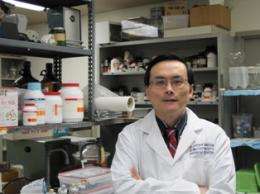Team demonstrates breakthrough method of stem cell expansion

(Medical Xpress) -- Researchers in the Department of Pathology at Stony Brook University School of Medicine have discovered a laboratory method to expand adult hematopoietic stem cells (HSCs) using the SALL4 gene. Professor Yupo Ma, M.D., Ph.D., Lead Author, and colleagues used this method to produce a more than 10,000-fold increase in HSCs derived from normal human bone marrow. Their findings define a new mechanism of stem cell self-renewal, providing a means to produce large numbers of HSCs that could be used to treat hematological malignancies and other blood disorders. Their results are reported in the early online edition of Blood.
HSCs are rare cells capable of differentiating into all blood cell lineages. These cells are used in clinical procedures to treat various blood diseases, including leukemia and lymphoma, and are central to bone marrow transplantation. Only one in three patients in need of bone marrow transplantation are matched with a suitable donor, and thus many patients die before finding a match. The Stony Brook research team’s discovery of using SALL4, which produces a protein that stimulates HSCs to grow, may be a critical first step to finding a treatment based on the expansion of HSCs that could become one alternative to finding a matched donor.
“Investigators have been trying to expand human HSCs for 30 years, but so far there have been only small incremental advances without clinically meaningful results,” says Dr. Ma. “We believe our findings are so different from others that this method could open the door to a process that expands HSCs and be used clinically.”
The research team, spearheaded by co-author Jerell R. Aguila, Ph.D., devised a way to transfer a stem cell gene (SALL4) into human bone marrow HSCs (CD34+ and CD38-) using a viral delivery system. Once the cells started producing the SALL4 protein, they were exposed to chemical agents known as cytokines, in order to mimic the environment of normal bone marrow.
By using SALL4 transduction methods, Dr. Ma’s team of investigators was able to increase the number of HSCs by a factor of 10,000-to-15,000 fold. Subsequently, the team demonstrated that these cells could replace and expand into bone marrow stem cells. The team then successfully transplanted cells from primary recipients and transplant them into a secondary recipient, and from the secondary recipient into a tertiary recipient.
Data presented in the Blood article, titled “SALL 4 is a robust stimulator for the expansion of hematopoietic stem cells,” support the conclusion that this new method is far superior to existing approaches. Using the SALL4 transduction methodology, they found HSC expansion consistently resulted in 10,000-to-15,000 fold increases in the cells. Previous methods to expand HSCs have had limited success, with a 160-fold increase achieved by only one of the methods.
Furthermore, no adverse effects were detected in animal models that were monitored for more than 12 months. Dr. Ma’s team was also able to eliminate the need for viral delivery of SALL4 by generating a novel recombinant (TAT-SALL4) protein, making it possible to translate their work into the clinical setting.
“The achievement of Dr. Ma and his research team is an important milestone along the road to developing new methods to treat leukemia and lymphoma and may someday be applied to create stem cells from other tissues, including heart, pancreas, and muscle,” says Kenneth Shroyer, M.D., Ph.D., Chair of the Department of Pathology at Stony Brook University School of Medicine.
“Ultimately, this method could accelerate the use of stem cell therapies for cancer, as well as a broad range of other diseases,” Dr. Shroyer adds.
















